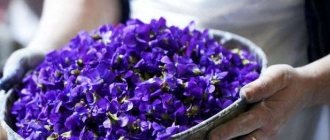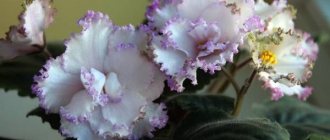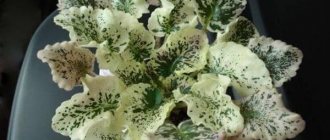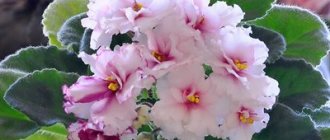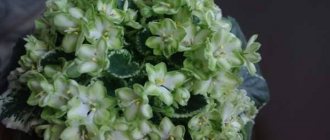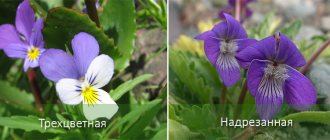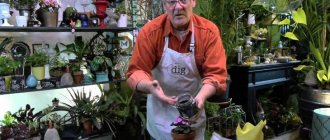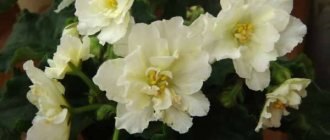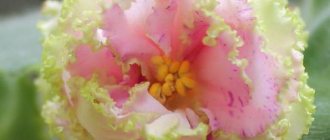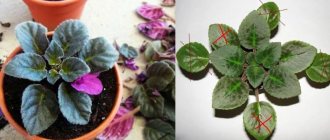In every flowerbed you can find at least one variety of violets . These flowers are so popular due to the variety of shapes and colors, as well as their unpretentiousness.
Most varieties belong to wild species , and only a few have been bred by breeders. Forest varieties are very popular among flower lovers. Let's find out in more detail what forest violet looks like - photos and names.
Violet, description and photo RS-Dryad (S. Repkina)
Violets from breeders of the CIS countries - “D” (RS).
RS- Dryad (S. Repkina).
RS-Dryad, RS-Driada (S. Repkina).
Very unusual semi-double and double stars of lilac-green color with light fantasy. Fantasy is white, light lilac and light green depending on the color of the background on which it is located. There are no author's descriptions by S. Repkina, so it is useless to look for them; determine your variety or sport yourself. The variety is for everyone.
Dark green flat toothed leaves. Standard. An even rosette on elongated petioles can lift the leaves upward.
Original double and semi-double lilac-swamp flowers with elongated petals in the shape of a bell with light peas. When blooming, the flowers are bright with a distinct light fantasy, but then they lighten up, only the dark “ears” remain bright. Green darkening along the edges of the petals depends on the temperature when the buds are laid and on the age of the rosette.
Violet flowers are somewhat similar to crocus flowers. The violet attracts precisely because of its unusualness; I like the scorch markings, the unbroken coloring, and the shape of the flower. Flower size up to 5 cm.
A long-flowering variety due to the green color of the petals. Flowering lasts up to 2 months, and new flowers are constantly added. There are 3-4 buds on the peduncles. The peduncles are long and fall apart in different directions. Different colors of flowers on different peduncles - for every taste. In hot weather it blooms without any swamp shadows, but when it gets cooler, then they are there.
The variety is very sporty, up to 70%. Sports in different shades of lilac-violet, pink, green and brown with and without polka dots. It is necessary to raise all the children until they bloom. This variety has very large bracts, the flower stalks take root without problems. To get a normal outlet you need to keep it in good and correct light.
RS-Dryad, RS-Palmyra and RS-Wild Forest - these varieties can be combined into a “series”, based on the color and shape of the flower.
Dryads (ancient Greek - tree, in particular oak) - in ancient Greek mythology, forest nymphs, patroness of trees. Sometimes dryads were named after trees. The oldest known nymphs are dryads, born from drops of the blood of Uranus and living in Ash. Dryads are a few of the nymphs who are mortal. It was believed that dryads were inseparable from the tree with which they were connected and died when the tree died. There was a belief that people who plant and care for trees enjoy the special protection of tree nymphs. For damaging or destroying trees, dryads could severely punish a person, for example, deprive him of his mind.
Do you know that…?
Leaves with light yellow spots occur when burned from direct sunlight, leaves with brownish spots - when watered with cold water, pale green with curved edges - when the room temperature is low. Yellowing over the entire surface, especially the lower ones - due to dry air and incorrectly selected soil, size and quality of the pot. Leaves with a colored coating - with systematic flooding.
Before you buy the violets listed below, carefully read the forums about their behavior on the windowsill. Many of them are very beautiful flowers. However, these can be large rosettes with large and fragile leaves, with leaves rising up or hugging the pot, forming many stepsons that interfere with the formation of a neat rosette, pulling the stem up and growing into a Christmas tree, bending the trunk, rare flowering with long breaks, fallen flowers or they last little and quickly wither, very long and recumbent peduncles, the color of the flower fades quickly, they do not like bright lighting on the windowsill, they are afraid of the slightest drying out or waterlogging, a large percentage of them go into sports or darken the flower.
Are they suitable for your window sill and the conditions that you can create for them? You will look at the flowers for several months, and the rosette will always be in front of your eyes. There are many beautiful flowers, there are much fewer beautiful and neat rosettes, look first at the rosette! Search and you may find a dozen violets with the same flower color if you are not interested in the smallest details as a collector.
• — Desdemona (Repkina); • — Demon (Repkina); • — Gin (Repkina); • — Diva (Repkina); • — Wild Forest (Repkina); • — James Bond (Repkina); • — Brownie (Repkina); • — Drakosha (Repkina); • - Dulcinea (Repkina);
Domestic selection. Varieties of Arkhipov, Morev, Korshunova, Kraiduba and other breeders
- AB-Autumn Forest - KZ-Walk in the Sun
- LE-... (Lebetskaya variety)
- LiK-White Angel - NiL-Shamakha Queen
- PT-… (Pugacheva variety)
- RM-… (Skornyakova variety)
- RS-… (Repkina varieties)
- Holy Naivety - YAN-Dressy
For fans of domestic selection, the catalog includes beautiful and very interesting varieties from the most popular breeders of Russia and Ukraine.
The following symbols are used in the catalog:
- N – new selections from 2013 – 2014;
- Nk – new items in this catalogue;
- L – varieties that will be sold in the summer after mandatory prior approval (will be grown only by summer);
| 41 N | AV-Autumn Forest (Tarasov) | Simple semi-double bell stars, light pink in the center with a fuchsia-purple wide braid and ruffles in various shades: green, marsh, golden. Flowers leave the impression of being immersed in the atmosphere of an autumn forest. Flowers last for several months. The rosette is flat, with shiny wavy dark leaves. | 150 L |
| 42 | AE-Sharlene Nostalgie Sharlene Nostalgie (Arkhipov) | Large double rich lavender stars with a large white eye, white wavy edges of the petals and abundant contrasting blue fantasy (flowing strokes, dashes, specks). Quilted green leaves. Refined and noble variety. | 80 |
| 43 | AE-Aquarius (Arkhipov) | Very large, round, wide-open “saucer” flowers of blue-blue color with a purple tint; Contrasting white and pink peas are scattered throughout the background of the petals. Bright green foliage with short petioles. | 80 |
| 45 | AE-Milky Way (Arkhipov) | Large, deep plum-purple double stars with abundant reddish-pink fantasy polka dots. Very contrasting, very effective variety. Dark green simple leaves. | 80 |
| 47 | Amadeus (Morev) | Large, densely double rounded red-crimson flowers with a wide white border and center. As the flower opens, the color becomes more saturated. The foliage is dark green and flowers abundantly. | 80 |
| 49 Nk | EK-Ruby in Emerald (Korshunova) | Very large semi-double dark ruby velvety flowers with emerald fringed edges of the petals. Exhibition dark green rosette of simple leaves. A rich combination of ruby and emerald shades. | 100 |
| 50 | Winter Smiles (Makuni) | The flowers are double and semi-double, light pink with wine-red strokes on the edges of the petals and an elegant light green fringe. The leaves are green with an olive tint, rounded. A masterpiece of domestic selection. | 80 |
| 51 N | K-La Victoire de L'Amour (Crayduba) | Very large white and pink flowers. White rays from the center and the creamy pink edge of the petals create the impression of unusual airiness. Strong peduncles, green standard foliage. | 150 L |
| 53 N | K-Ksenia (Kraiduba) | A bright bouquet of large flowers. The colors include all variations of coral. Often on one rosette you can see almost white and dark coral flowers. Small variegated rosette, quilted foliage. | 100 |
| 54 | K-Obsession (Kraiduba) | Lilac-lavender flowers with darker fantasy on the petals. Variegated leaf. | 80 L |
| 55 N | K-Nadezhda (Kraiduba) | The flower is delicate, large, white, slightly touched with pink along the edge. Neat outlet. | 100 |
| 56 N | K-Dangerous Desires (Kraiduba) | Large red-plum pansies with a greenish ruffle. Variegated leaf. | 100 |
| 57 | K-Thaw (Kraiduba) | Large, double white and pink flowers with a fringed edge of the petals, sometimes decorated with a green ruffle. A small rosette of small serrated leaves. | 80 |
| 58 N | K-Awakening (Kraiduba) | Bell-shaped white simple flowers with a chimeric type of color. Along the lilac-blue edge is a darker fantasy. Simple green neat foliage. | 100 |
| 59 | K-Undine (Kraiduba) | Large, double white-blue flowers on a medium-sized rosette of small, medium-green leaves. | 80 |
| 60 N | K-Sharman (Krayduba) | The pansies are blooming pink. Over time, dark fuchsia streams appear on them, which become even darker with age. | 100 L |
| 61 N | K-Southern Night (Kraiduba) | Large blue pansies with rare pink and white fantasy on a light variegated rosette. | 100 |
| 62 | KZ-Danochka (I. Zaikina (Werner)) | Heavily wavy, notched stars in a distinct lemon tone with a pink border! Wavy foliage. | L |
| 63 | KZ-Walk in the Sun (I. Zaikina (Werner)) | Yellow-flowered seedling. Heavily wavy, notched terry stars with a pronounced lemon tone! Abundance of flowers, light foliage. | L |
- LE-... (Lebetskaya variety)
- LiK-White Angel - NiL-Shamakha Queen
- PT-… (Pugacheva variety)
- RM-… (Skornyakova variety)
- RS-… (Repkina varieties)
- Holy Naivety - YAN-Dressy
Danilina Irina Leonidovna
Telephone for communication and orders, 8-917-545-6727 (mobile)
Details about ordering plants and their delivery throughout Russia are in the How to order section.
Description of forest violet
Wild violet belongs to the Violet family. There are several hundred species of this perennial flower. The plant forms shoots no more than 15 cm, flowers of 5 petals are formed on peduncles. Depending on the type, it can have different colors: white, blue, purple, yellow and various combinations of these colors with all possible shades.
What does a forest violet look like?
For your information! Forest violet, or viola, grows mainly in northern latitudes and is adapted to harsh climatic and temperature conditions. The natural habitat conditions of the plant determine the characteristics and requirements for caring for it when grown in the garden.
Briefly about the history of appearance
East Africa is recognized as the homeland of the forest violet. From this region the culture spread to other latitudes. Since 1893, the plant began to be actively cultivated in horticulture, thanks to which the beloved pansies of various varieties, sizes and colors were obtained. Today, violets can be found in North America and even in Japan.
How are they different from indoor
The so-called indoor violets (Saintpaulias) are in no way related to forest violets. The flowers belong to different families and grow in different conditions, although both are herbaceous and similar in flower shape.
Note! Saintpaulia, unlike unpretentious wild violets, does not tolerate direct sunlight and water on the leaves, which can even cause death.
Common varieties
Many species of wild violets are now extremely rare and are included in the Red Books. In Russia, about 20 species can be found in natural conditions.
Features of the view
When grown in a garden in a flower bed, forest violet, as in nature, tends to occupy a large area. To control the growth of the flower, you need to regularly pinch the shoots.
Creeping stems perfectly fill the space of alpine slides, forming a flowering carpet. Planted in the shade, the viola will have paler flowers, but the flowering period itself will be longer. It is recommended to select elevated areas to avoid stagnation of moisture at the roots.
About pests
Sooner or later, any violet grower begins to feel (and this is the key word) that his violets are being eaten by a nasty mite. Mass poisoning of both plants and their family begins. Yes, yes, no matter how poison manufacturers assure us that the product is safe, it is still a poison that poisons both plants and ourselves. There is also a lot of information about preventive treatments for all kinds of pests. Don't believe this information! There is no prevention against pests!
If there are mites or mealybugs, then one preventive treatment will not do anything with them; at least 3 treatments are needed. That is, by spraying something once, we simply accustom the pest to the poison, and then it is very difficult to eradicate it. And if there is no pest, then who are we poisoning “for prevention”? The answer is obvious - yourself and your family.
Saintpaulia LE - Mont Saint Michel
So what should we do if we suspect a pest? First, determine what kind of pest it is and whether it exists in reality. It is advisable to go to a reputable violet forum on the Internet, where experienced people will figure it out. And only then begin any processing.
But it’s easier to prevent pests from entering the collection. To do this, we make sure to treat all new plants that come into our house. These are 3 treatments with anti-mite preparations (for example, Fitoverm) and at least 2 treatments for mealybugs (for example, Aktara). They poisoned it and forgot about it. Quarantine for new plants is useless; a mite, for example, may not manifest itself for up to 6 months.
It is very difficult to mention all the nuances of growing violets in one article, but I tried to tell you about the main ones, but did not draw your attention to the most important and mandatory condition - love for these beautiful flowers. Love your plants and they will definitely love you back!
Saintpaulia Blue Mist
[/td]
|
Recommendations for planting and caring for wild violets
Wild violets take root quite easily in garden conditions. The main thing is to initially choose the right place and decide on the method of cultivation.
Wild viola in the garden
Soil, lighting, degree of moisture
The quality of the soil in which wild violets grow can vary significantly depending on the type of plant. Some violas prefer soil with a slightly acidic reaction, while others prefer an alkaline one; some need loose, light soil, while others need dense and moist soil.
When and how does it bloom
The flowering period of wild violets differs depending on the type of flower and growing conditions. Most common varieties bloom continuously throughout the summer. Some violas, such as dog viola, hill viola and sweet viola, flower in late spring and early summer. No special additional care is required at this time.
Most wild violets have flowers consisting of five petals, 2 of which are located at the top and 3 at the bottom. They can be divided or fused at the base. The flowers of certain species, such as the rare cut violet, are more similar to cyclamen.
Appearance: leaves, flowers, etc.
Often, forest violet is not as bright as, for example, field violet. But she is good in her own way. The flowers are blue, violet, blue, lilac with a yellow center. Violets and white are found in the wild. The diameter of the flowers does not exceed 1.5 centimeters. By the onset of autumn, the flowers gradually transform into boxes with seeds. They have an oblong shape with a smooth surface.
The leaves are formed tightly to each other and form rosettes. Violet greens are smooth and velvety.
Not only the basal roots, but also the flower stalks are green. The top row of violets is much smaller in size than the bottom. The bud has five stamens with short filaments. The buds are single, consisting of five petals, lanceolate in shape. The flower stems are shortened. The plant reaches 12-15 centimeters in height.
Here are photos of forest violets.
Use of field violets in folk medicine
The plant contains essential oils, vitamins A, C, E and other beneficial substances.
Important! Due to the alkaloid content, wild Saintpaulia is poisonous, so it should be used with extreme caution and only under the supervision of a doctor.
The use of viola in medicine is possible after consulting a doctor
Forest viola can be used:
- to reduce temperature;
- for gargling a sore throat;
- as an expectorant;
- for headaches;
- as a diuretic, hemostatic, anti-allergenic, anti-rheumatic agent.
Note! In cosmetology it is used in creams to smooth out wrinkles and heal cracks.
Many people, having encountered a forest violet, do not think about the possibility of growing it on their property. However, wild varieties of viola can both decorate the garden and become raw materials for medicinal purposes.
Blue
Beautiful Saintpaulias that resemble the sky on a sunny warm day. Tender, vulnerable creatures that require care. They do not like drafts and quickly disappear under their influence. Common subtypes are Blue Blood, Fog and Bridal Bouquet. Saintpaulias have a presentable appearance and are given as gifts for birthdays, holidays, and special occasions.
Blue bloods are especially large stars. The edges of the petals are snow-white. The foliage does not fall out of the pot, the rosette is neat and sinewy. Flowering is long-lasting and does not change tone. The dark green leaves provide an excellent contrast to the light colored fruit. They bloom approximately a year after planting seeds or cuttings.
Blue fog is a heavenly color with lilac tints. Wave-shaped border with white edging. The flowers are large or medium spherical in shape. The buds are massive, stretching to the top. The Uzambara subtype was developed more than 15 years ago; it is recognized and loved in European countries and America.
Wedding bouquet - the description completely matches the name. This pansy looks elegant and solemn. The color is pure, with a silver coating. The size of the petals can reach 3-4 cm. The leaves are matte and smooth. Noble pansy, which blooms for 2-3 weeks several times a year.
Important! Blue Saintpaulias do not tolerate a drop in room temperature below 18 C. With excessive watering or moisture on the flowers and foliage, they quickly become ill and lose their attractive appearance.
RS-Reserved Forest
A little portrait. Growing on the shelf. We came to smile at the sun.
I really like the socket itself. It is absolutely not whimsical and forms itself. True, he refuses to take stepson, and for the better in my opinion. I can’t say that I’m completely delighted with the flowers. This one is even brighter, but her sister lives only because of the socket.
My sister started blooming earlier. But somehow it’s not active, maybe that’s why I don’t really like it. Peduncles in an upright position.
I want to say about the size: I’m very glad that I didn’t risk putting them in one bowl. I like it better this way.
What a wonderful baby
What a wonderful baby
I like the trailer, it's
I like the trailer, it has an interesting flower shape. And as an adult he will be even better.
Anya, cute pink
Anya, a cute pink trailer with good potential. It will still unfold to its full extent. After miniatures, trailers are my second weakness. I really like them, they look fun and playful from any angle.
Svetlana, thank you very much. I
Svetlana, thank you very much. I'm also a fan of trailers and miniatures. There are already a couple of mini-trailers. Lately I’ve been looking at those that can actively form themselves.
Anya, beautiful flower shape and
Anya, the beautiful shape of the flower and the color are loved by many. I like trailers too
They form rosettes on their own and bloom in voluminous caps. Congratulations on the flowering and it will surprise you with its beauty.
Thanks a lot. There is truth
Thanks a lot. There is really a chance that both of them will turn out to be sports. There are no fantasy touches. I'm hoping for a second bloom.
Thanks everybody. Grew up
Thanks everybody. They literally grew up very quickly. But for some reason the kids from the second wave don’t want to grow up like that. They've been sitting like that for a couple of months now, just crumbs.
Anya, you are very curious
Anya, your variety is very interesting.
Is there no fantasy at all or little? And is it standard or semi-mini?
Lyudmila, thank you. Bye
Lyudmila, thank you. While the varietal identity is in question.
I can’t find any strokes, but the beautiful fantasy-colored stains on this one are so mesmerizing. My sister had one stroke on the very first flower. That's all. Her flowers are simple faded pink. I can’t stop looking at this one, so many more flowers have opened and hang in clusters.
This is standard, but the sockets are neat. We don't look like the trailer yet.
Girls, we suddenly remembered
Girls, we suddenly imagine ourselves to be a chimera. There are already 2 flowers like this. I don’t know if the photo turned out, I’ll post the camera if it works. But one flower also clearly turned blue.
Temperature
There is often information on the Internet that the ideal temperature for violets is from +18°C to +25°C. In practice, I can say that my racks never drop below +30°C. Well, I don’t have the ideal temperature in my apartment, but at the same time I even manage to participate in exhibitions. Conclusion: violets are so tenacious that even +30°C is a very suitable temperature for them.
Saintpaulia VaT-Veronica
Reminder for a newbie!
Uzambara (Uzumbar) violet is a plant of the Gesneriaceae family, growing in the natural environment of tropical and subtropical regions of Asia, Africa, Eastern Australia, South America and the Indian Ocean islands.
Saintpaulia is a plant named after the Saint-Paul father and son, who brought a plant unknown to Europeans from the Uzambara district (modern Tanzania) in the 19th century, presented for the first time at the international flower exhibition in Ghent in 1893.
Indoor violet has been one of the most popular plants in indoor floriculture since 1927. By 1949, more than 100 varieties had been bred, and today their number exceeds several thousand.
Rooting
- possibly in water, in substrate, moss.
Priming
- purchased soil or a mixture of leaf, coniferous, turf and peat soil in a ratio of 3:1:2:1 with the addition of raising agents (perlite, vermiculite, river sand, crushed sphagnum moss.
Lighting - it is best to place flower pots on western or eastern windows. To ensure that the plant is evenly illuminated from all sides, the pots are periodically rotated. In winter, when daylight hours decrease, you can use artificial lighting - fluorescent lamps.
Caring is a real art and serious painstaking work at the same time, including watering, fertilizing, and creating a favorable humid climate. Water Saintpaulias as the soil dries. The soil must be moistened regularly, but excess moisture should not stagnate in the roots. When watering, you must ensure that water does not get on the leaves. You cannot water the Uzambara violet with cold water. Fertilizing is done with complex mineral fertilizer once every two weeks. Saintpaulia reacts negatively to a lack of nitrogen in the soil. Optimal air humidity is approximately 50%, temperature is 20-22 ° C, without sudden fluctuations and drafts. The leaves of the plant should not touch the window glass. Removal of faded flowers and damaged leaves is carried out regularly.
Reproduction - planting a leaf cutting, part of a leaf, or a daughter rosette. The most popular method is rooting leaf cuttings. The formation of roots and the development of children lasts 4-8 weeks.
Pests are one of the gardener's problems. There are many different types of pests and it is very difficult to classify them. Among Saintpaulia pests, several groups can be distinguished: mites (spider mites, flat mites, transparent mites, etc.), insects (aphids, thrips, springtails, poduras, scale insects, whiteflies, scale insects, etc.), worms (nematodes).
Diseases - distinguish between infectious (gray rot, powdery mildew) and non-infectious diseases (rotting of the stem and root, wilting of the lower leaves, yellowing, leaf spotting, incomplete opening and premature drying, falling of flowers) of plants. The causative agents of infectious diseases are bacteria, fungi, and viruses. To prevent infectious diseases, you should strictly observe the regimes of watering, temperature, humidity, and lighting. Non-communicable diseases usually arise due to poor agricultural practices. They may appear in one instance and not spread to others.
Possible diseases
During the growing process, flower growers may encounter various types of diseases. The most important thing here is to notice the disease in time and take urgent measures.
- Root rot is the most dangerous disease for a flower. It often appears at low temperatures and high humidity. The disease is transmitted by pathogenic fungi that can be stored in the soil for a long time. Infection begins from the roots.
- Phytophthora is another dangerous mushroom. It enters the plant through the pistil or root hairs.
- A white coating is a witness to downy mildew. A very unpleasant disease that occurs with improper care.
- Leaf petiole rotting is another rare disease. Appears as a result of contact with moss or in extreme heat.
Often, some diseases appear due to improper care. For example, rot can occur as a result of excessive watering, which leads to rotting of the roots.
In order to choose a variety of violets suitable for cultivation, we recommend studying articles about the mysterious “Fairy”, graceful “Cherry”, lushly blooming “Bronze Horseman” and “Isadora”, popular “Pansies”, the lily-of-the-valley “Greenhouse effect”, unusual “ Chanson”, the exquisite “Blue Mist”, as well as about everyone’s favorite varieties of the “Optimara” series.
RS wild forest violet
There are more than five hundred varieties of violets in the world. They can be found in the wild and also bred as a garden or houseplant. Some types of violets are favorite plants in flower beds. Being an excellent honey plant, the flower is also used as a remedy. For medical purposes, the description of forest violet is suitable for the treatment of headaches, as an expectorant, anti-inflammatory, diuretic, disinfectant, sedative and blood purifier.
Tricolor violet can be used as a remedy to combat fever, allergies, or as a diuretic.
Forest violet and its characteristic features
The genus forest violet is the violet family.
A representative of the flora, widely distributed around the globe, especially in the Northern Hemisphere, tropical and subtropical regions. These flowers feel comfortable in the mountains, as well as in regions with a temperate climate. A beautiful perennial plant, wild violet begins to bloom in April-May and can also re-enter the flowering period in late summer. Forest senopoly is distinguished by blue, dark purple, lilac, blue flowers interspersed with yellow. The inflorescences with a strong aroma reach one and a half centimeters in diameter. The forest violet can grow up to 15 centimeters in height. This plant does not have a stem as such. The creeping thick rhizome of the forest violet sends out shoots, on which new rosettes of leaves appear on petioles of 10-15 centimeters. Heart-shaped or rounded leaves are arranged in a rosette so that their top row is much smaller in size than the bottom. The plant is pubescent over its entire surface. During the winter, the leaves do not die off, but remain under the snow. Forest senopoly is a self-pollinating flower that reproduces vegetatively.
Appearance: leaves, flowers, etc.
Violet le-whipped cream
Often, forest violet is not as bright as, for example, field violet. But she is good in her own way. The flowers are blue, violet, blue, lilac with a yellow center. Violets and white are found in the wild. The diameter of the flowers does not exceed 1.5 centimeters. By the onset of autumn, the flowers gradually transform into boxes with seeds. They have an oblong shape with a smooth surface.
The petals of the plant vary in shape. All leaves are basal and have a variety of shapes: kidney-shaped, heart-shaped, rounded, ovate, with long petioles. There are small notches along their edges.
The leaves are formed tightly to each other and form rosettes. Violet greens are smooth and velvety.
Not only the basal roots, but also the flower stalks are green. The top row of violets is much smaller in size than the bottom. The bud has five stamens with short filaments. The buds are single, consisting of five petals, lanceolate in shape. The flower stems are shortened. The plant reaches 12-15 centimeters in height.
Garden viola for growing in a summer cottage
Senopolya is an unpretentious guest of even a novice gardener's site. Such violets can be grown both in sunny meadows and in dark places. and insufficient light, the plant takes root well, but does not bloom as profusely or brightly. Growing senopoly in the shade, gardeners noticed that the flowers received a more faded color, but a much longer flowering period. Light, slightly acidic soil with a moderate amount of moisture is suitable for growing garden violets. Despite the fact that the plant is moisture-loving, stagnation of water in the area can be detrimental to this flower, so the plant is not planted on uneven surfaces. Many people value garden viola not only for its ease of care and unpretentiousness, but also for its frost resistance.
Bloom
The main charm of all types and varieties of garden violas lies in the delicate flowers of these plants. To obtain abundant and long-lasting flowering, you should know some nuances.
Deadlines
The onset of the flowering period depends entirely on the varietal characteristics of the specimen and proper care of the violet.
Typically the buds open in mid to late spring. The earlier the seeds were sown in the ground or for seedlings, the sooner you can expect flowers to appear.
CAREFULLY! When planting seedlings or sowing seeds directly into the soil, the onset of late spring cold cannot be ruled out. You should check the long-term forecast and also rely on your own observations
This will protect the plantings from freezing.
Violets, according to the variety, have their own preferences in terms of flowering:
- Some form buds in the spring (Labrador, moth);
- Others may bloom towards the end of summer.
The graceful violet is strewn with flowers from late spring to early autumn.
Perennial garden violas can also prepare a surprise in the form of secondary flowering closer to autumn.
Age of onset
Annual garden violets bloom 2.5 - 3 months after sowing.
Biennial species can form buds only in the second year of life, although the cutting method can speed up this process.
Perennials, when sown with seeds, bloom like biennial species - in the second year of life, but when cuttings or dividing the bush they are able to produce flowers in the same year after rooting and adaptation.
Extension methods
The flowering period of garden violets can be increased with the correct agrotechnical methods:
- Providing the necessary daylight;
- Compliance with the watering regime;
- Feeding with phosphorus and potassium during the formation of buds.
ADVICE! Removing dried flowers also lengthens the duration of flowering and maximizes the number of formed corollas.
Lyubka bifolia plant
Lyubka bifolia is a plant that is also known as night violet, which is an orchid of the forest. She is distinguished by exquisite beauty. The plant blooms with white inflorescences collected in a long spike. The crowning stem on which the flowers are located can reach sixty centimeters. The period when Lyubka bifolia delights others with its delicate flowers is the beginning of June-July. The plant is loved by many nature connoisseurs due to its pleasant aroma, which intensifies in cloudy times and in the evening.
Diseases
Although violets are truly resilient and are not afraid of frost, they still have a weakness - illness. Alas, they also apply to such beautiful delicate plants.
- One of the most dangerous diseases for wild violets is root rot. Typically, the plant becomes infected at low temperatures and high humidity. Usually this disease is caused by pathogenic fungi that tolerate low temperatures and can be stored in the soil for a long time. Infection usually starts from the roots of plants.
- Another no less dangerous mushroom for violets is late blight. Penetrates into the plant mainly through the pistil, root hairs and stomata.
- Downy mildew also affects unfortunate plants and is one of the most unpleasant diseases for a flower. A white powdery coating forms on the leaves and flowers.
- There is also rotting of leaf petioles, a rather rare disease that occurs in extreme heat when leaf petioles come into contact with moss.
There are several other dangerous diseases:
- bacterial damage to leaves;
- non-infectious rot, when as the temperature drops, violet leaves begin to gradually fade;
- leaf chlorosis.
Viral diseases include variegation.
Indoor violets: growing features
The types of indoor violets bred by breeders differ from natural ones in a much greater color variety.
Having undergone changes and increased the range of colors, senopoly has become a favorite flower for creating a large collection on the windowsill. Due to their unpretentiousness and abundant flowering, which can be stimulated even by artificial lighting, these plants have gained particular popularity among novice gardeners. Read about which pots are best for violets here.
Violet Forest Nymph
An indoor flower such as the Forest Nymph violet attracts many collectors with its large, delicate green-bluish pansies. They have dark blue veins on the lower petals.
Violet Forest Fairy
The Forest Fairy violet plant has colorful star-shaped inflorescences. They can be a rich pink color that fades to a lighter color. In the center of the inflorescences they have a thick light green frill. Flowers of this species can be simple or double. They are quite large and can reach up to 4.5 centimeters. Forest Fairy Sheets are frilly. They are distinguished by their medium green color and burgundy underside.
Violet Forest Pearl
On the white petals of the inflorescence there are rare pale lilac inclusions. The Forest Pearl violet plant has an intermittent border around the edges of the flowers of a greenish tint.
Violet Forest Blackberry
This species is distinguished by its huge star flowers, which can reach up to seven centimeters. The Violet Woodland Blackberry plant has fluffy, wavy, ruffled inflorescences above a green rosette that are a rich blackberry-purple hue.
Violet Makuni or Forest Magic
Makuni is the second name given to the Forest Magic violet, which is distinguished by crimson flowers with a light green fringe along the edge of each petal. This type of senopoly is characterized by a compact rosette and wavy leaves of a dark green hue. Experienced collectors of varieties of this plant notice that the Forest Magic violet is quite difficult to care for. The formation of the rosette is difficult and slow. If you grow Makuni from leaf cuttings, this variety requires more attention. The fastest rooting of cuttings occurs in a greenhouse. Another of the Makuni varieties is the Lesnaya Skazka violet, which has double pink flowers and greenish-white fringed edges of the petals. The compact rosette of this senopoly variety is characterized by elongated, toothed leaves.
Violet Forest King
A variety of indoor plants, the Forest King violet, is characterized by bright purple, medium-sized stars. Each flower has white stripes and attracts attention with its bright green border. The plant has a variegated wavy rosette and abundant flowering that lasts a very long time. The flower is very easy to care for and is suitable for cultivation even by novice gardeners.
Senopoly Forest Lace
A variety such as the Forest Lace violet is distinguished by very elegant simple or semi-double white flowers that have a green or green-golden fringe. The ruffled foliage is dark green.
SM-Mriya
Gigantic, on powerful peduncles, densely double creamy-pink “balls”-stars are abundantly striped with strokes, stripes and sectors of bright purple fantasy. Plus thick lavender specks on the petals. Rich green foliage.
Breeder Morev K.
You can contact me on the pages
Guarantees:
When choosing any planting material on my website (leaf, baby, leaf fragment or stepson), I guarantee that they will be well packaged and will reach you safe and sound.
I am not responsible if they get damaged due to your fault.
If something gets spoiled due to the fault of the post office, then with your next order I can give you the damaged variety as a gift.
